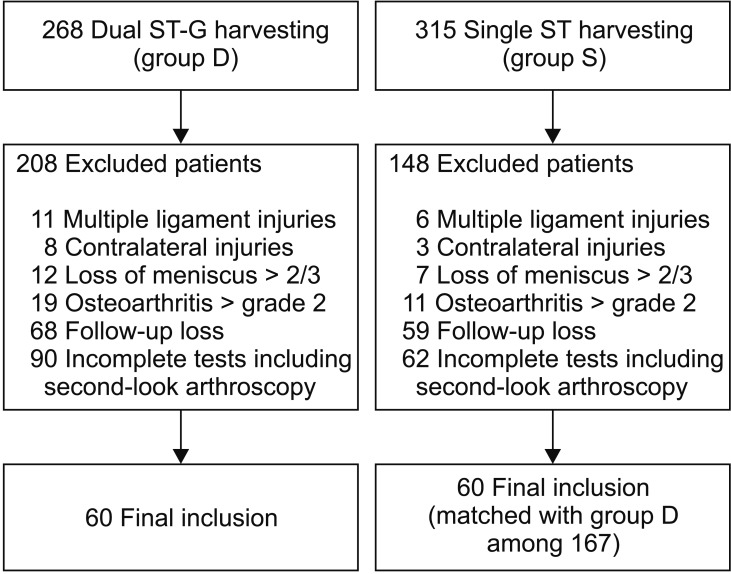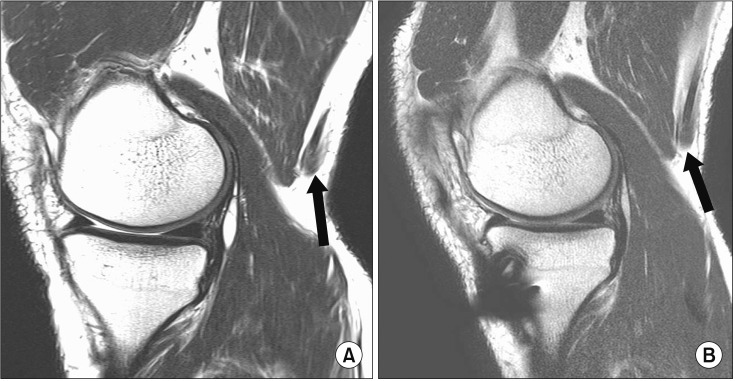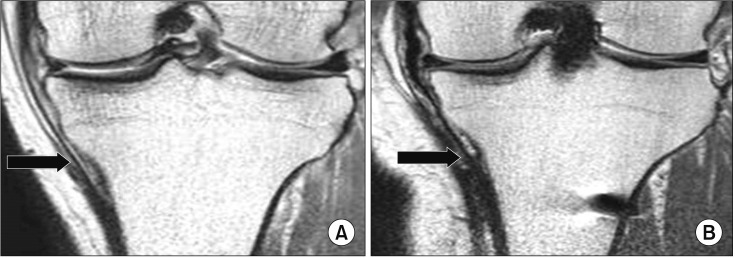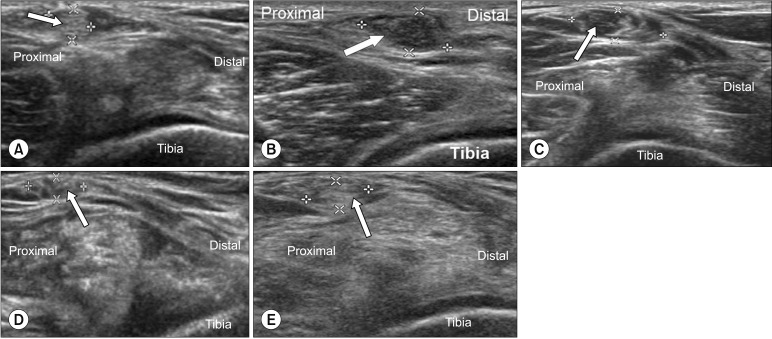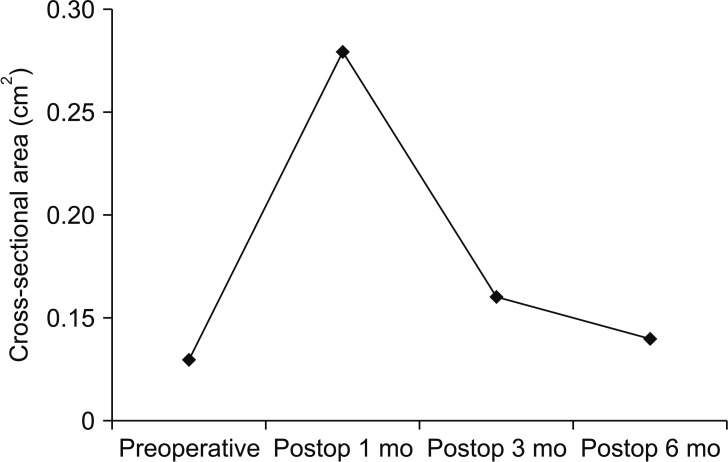Clin Orthop Surg.
2019 Mar;11(1):60-72. 10.4055/cios.2019.11.1.60.
Functional Effects of Single Semitendinosus Tendon Harvesting in Anatomic Anterior Cruciate Ligament Reconstruction: Comparison of Single versus Dual Hamstring Harvesting
- Affiliations
-
- 1Department of Orthopaedic Surgery, Konkuk University Medical Center, Seoul, Korea. boram107@hanmail.net
- 2Department of Radiology, Inje University Seoul Paik Hospital, Seoul, Korea.
- 3Sports Medical Center, Konkuk University Medical Center, Seoul, Korea.
- KMID: 2438335
- DOI: http://doi.org/10.4055/cios.2019.11.1.60
Abstract
- BACKGROUND
This study aimed to determine the effects of single semitendinosus tendon (ST) harvesting for anterior cruciate ligament (ACL) reconstruction by comparing outcomes of single ST and semitendinosus-gracilis tendon (ST-G) harvesting.
METHODS
ACL reconstruction with ST-G harvesting (D group, n = 60) or single ST harvesting (S group, n = 60) were included according to inclusion criteria. Subjective assessments included subjective International Knee Documentation Committee score, Lysholm score, and Tegner activity scale score. Objective assessments included isokinetic strength and functional tests. These tests were completed at 36 months of follow-up. Magnetic resonance imaging (MRI) and second-look arthroscopy findings were evaluated. In the S group, regeneration properties were assessed by serial ultrasonography (US).
RESULTS
The S group showed significantly less deep flexor strength deficit than the D group (p < 0.001). Deep flexor power deficits showed significant correlation with the shift of musculotendinous junction of the ST. There was significant difference in the cocontraction test between the groups (p = 0.012), and the S group tended to show better results in other functional tests at the last follow-up. There were no significant differences in graft tension and synovial coverage on second-look arthroscopy between the groups. In the S group, the regeneration rates assessed by US at the joint line and distal insertion were 81.7% and 80%, respectively at 6 months of follow-up.
CONCLUSIONS
The S group showed significantly less deficit in deep flexor strength and tended to show better clinical results at the last follow-up than the D group. In the S group, more than 80% showed good regeneration at the 6-month follow-up. Hence, single ST harvesting is effective in minimizing flexor weakness and functional deficits and shows great potential for regeneration.
Keyword
MeSH Terms
Figure
Cited by 1 articles
-
Current Trends and Future Developments in Anterior Cruciate Ligament Reconstruction: Current Concepts Review
Dhong Won Lee, Ji Nam Kim, Se Woong Kim, Seung Ik Cho, Na Yeon Kim, Byung Sun Park
Korean J Sports Med. 2023;41(4):185-200. doi: 10.5763/kjsm.2023.41.4.185.
Reference
-
1. Chee MY, Chen Y, Pearce CJ, et al. Outcome of patellar tendon versus 4-strand hamstring tendon autografts for anterior cruciate ligament reconstruction: a systematic review and meta-analysis of prospective randomized trials. Arthroscopy. 2017; 33(2):450–463. PMID: 28040335.
Article2. Kim JG, Yang SJ, Lee YS, Shim JC, Ra HJ, Choi JY. The effects of hamstring harvesting on outcomes in anterior cruciate ligament-reconstructed patients: a comparative study between hamstring-harvested and -unharvested patients. Arthroscopy. 2011; 27(9):1226–1234. PMID: 21875529.
Article3. Yosmaoglu HB, Baltaci G, Ozer H, Atay A. Effects of additional gracilis tendon harvest on muscle torque, motor coordination, and knee laxity in ACL reconstruction. Knee Surg Sports Traumatol Arthrosc. 2011; 19(8):1287–1292. PMID: 21298255.
Article4. Janssen RP, van der Velden MJ, Pasmans HL, Sala HA. Regeneration of hamstring tendons after anterior cruciate ligament reconstruction. Knee Surg Sports Traumatol Arthrosc. 2013; 21(4):898–905. PMID: 22763570.
Article5. Sharma A, Flanigan DC, Randall K, Magnussen RA. Does gracilis preservation matter in anterior cruciate ligament reconstruction? A systematic review. Arthroscopy. 2016; 32(6):1165–1173. PMID: 26874800.
Article6. Karimi-Mobarakeh M, Mardani-Kivi M, Mortazavi A, Saheb-Ekhtiari K, Hashemi-Motlagh K. Role of gracilis harvesting in four-strand hamstring tendon anterior cruciate ligament reconstruction: a double-blinded prospective randomized clinical trial. Knee Surg Sports Traumatol Arthrosc. 2015; 23(4):1086–1091. PMID: 24531357.
Article7. Stevanovic V, Blagojevic Z, Petkovic A, et al. Semitendinosus tendon regeneration after anterior cruciate ligament reconstruction: can we use it twice. Int Orthop. 2013; 37(12):2475–2481. PMID: 23982635.8. Bedi A, Srinivasan RC, Salata MJ, Downie B, Jacobson JA, Wojtys EM. Structural and functional analysis of the semitendinosus tendon after harvest for soft tissue reconstructive procedures: a dynamic ultrasonographic study. Knee Surg Sports Traumatol Arthrosc. 2013; 21(3):606–614. PMID: 22476527.
Article9. Konrath JM, Vertullo CJ, Kennedy BA, Bush HS, Barrett RS, Lloyd DG. Morphologic characteristics and strength of the hamstring muscles remain altered at 2 years after use of a hamstring tendon graft in anterior cruciate ligament reconstruction. Am J Sports Med. 2016; 44(10):2589–2598. PMID: 27432052.
Article10. Lee DW, Kim JG. Anatomic single-bundle anterior cruciate ligament reconstruction using the modified transtibial technique. Arthrosc Tech. 2017; 6(1):e227–e232. PMID: 28409105.
Article11. Lee DW, Kim JG, Lee JH, Park JH, Kim DH. Comparison of modified transtibial and outside-in techniques in anatomic single-bundle anterior cruciate ligament reconstruction. Arthroscopy. 2018; 34(10):2857–2870. PMID: 30197202.
Article12. Carofino B, Fulkerson J. Medial hamstring tendon regeneration following harvest for anterior cruciate ligament reconstruction: fact, myth, and clinical implication. Arthroscopy. 2005; 21(10):1257–1265. PMID: 16226656.
Article13. Eriksson K, Larsson H, Wredmark T, Hamberg P. Semitendinosus tendon regeneration after harvesting for ACL reconstruction: a prospective MRI study. Knee Surg Sports Traumatol Arthrosc. 1999; 7(4):220–225. PMID: 10462211.14. Choi JY, Ha JK, Kim YW, Shim JC, Yang SJ, Kim JG. Relationships among tendon regeneration on MRI, flexor strength, and functional performance after anterior cruciate ligament reconstruction with hamstring autograft. Am J Sports Med. 2012; 40(1):152–162. PMID: 21993976.
Article15. Noyes FR, Barber SD, Mangine RE. Abnormal lower limb symmetry determined by function hop tests after anterior cruciate ligament rupture. Am J Sports Med. 1991; 19(5):513–518. PMID: 1962720.
Article16. Jang SH, Kim JG, Ha JK, Wang BG, Yang SJ. Functional performance tests as indicators of returning to sports after anterior cruciate ligament reconstruction. Knee. 2014; 21(1):95–101. PMID: 24075101.17. Guo L, Chen H, Luo JM, Yang L, Gu LC, Fu DJ. An arthroscopic second-look study on the effect of remnant preservation on synovialization of bone-patellar tendonbone allograft in anterior cruciate ligament reconstruction. Arthroscopy. 2016; 32(5):868–877. PMID: 26821962.
Article18. Noh JH, Yang BG, Roh YH, Lee JS. Synovialization on second-look arthroscopy after anterior cruciate ligament reconstruction using Achilles allograft in active young men. Knee Surg Sports Traumatol Arthrosc. 2011; 19(11):1843–1850. PMID: 21409462.
Article19. Nakamura N, Horibe S, Sasaki S, et al. Evaluation of active knee flexion and hamstring strength after anterior cruciate ligament reconstruction using hamstring tendons. Arthroscopy. 2002; 18(6):598–602. PMID: 12098120.
Article20. Tashiro T, Kurosawa H, Kawakami A, Hikita A, Fukui N. Influence of medial hamstring tendon harvest on knee flexor strength after anterior cruciate ligament reconstruction: a detailed evaluation with comparison of single- and double-tendon harvest. Am J Sports Med. 2003; 31(4):522–529. PMID: 12860539.
Article21. Ohkoshi Y, Inoue C, Yamane S, Hashimoto T, Ishida R. Changes in muscle strength properties caused by harvesting of autogenous semitendinosus tendon for reconstruction of contralateral anterior cruciate ligament. Arthroscopy. 1998; 14(6):580–584. PMID: 9754475.
Article22. Tadokoro K, Matsui N, Yagi M, Kuroda R, Kurosaka M, Yoshiya S. Evaluation of hamstring strength and tendon regrowth after harvesting for anterior cruciate ligament reconstruction. Am J Sports Med. 2004; 32(7):1644–1650. PMID: 15494328.
Article23. Eriksson K, Kindblom LG, Hamberg P, Larsson H, Wredmark T. The semitendinosus tendon regenerates after resection: a morphologic and MRI analysis in 6 patients after resection for anterior cruciate ligament reconstruction. Acta Orthop Scand. 2001; 72(4):379–384. PMID: 11580127.
Article24. Thaker H, Sharma AK. Engaging stem cells for customized tendon regeneration. Stem Cells Int. 2012; 2012:309187. PMID: 22685473.
Article25. Suydam SM, Cortes DH, Axe MJ, Snyder-Mackler L, Buchanan TS. Semitendinosus tendon for ACL reconstruction: regrowth and mechanical property recovery. Orthop J Sports Med. 2017; 5(6):2325967117712944. PMID: 28680900.
Article26. Nakamae A, Deie M, Yasumoto M, et al. Three-dimensional computed tomography imaging evidence of regeneration of the semitendinosus tendon harvested for anterior cruciate ligament reconstruction: a comparison with hamstring muscle strength. J Comput Assist Tomogr. 2005; 29(2):241–245. PMID: 15772546.
- Full Text Links
- Actions
-
Cited
- CITED
-
- Close
- Share
- Similar articles
-
- Flexor Weakness and Clinical Outcomes after Hamstring Harvest in Anterior Cruciate Ligament Reconstruction: Comparison of Single- and Double-Tendon Harvesting Techniques
- Reconstruction of Posterior Cruciate Ligament Using Semitendinosus Tendon (3 cases)
- Clinical experience with woven and parallel hamstring-tendon anterior cruciate ligament reconstruction
- Smaller cross-sectional areas of the hamstring tendon measured from preoperative ultrasonography are likely to need additional gracilis harvesting for double-bundle anterior cruciate ligament reconstructions
- Clinical Results of Anterior Cruciate Ligament Reconstruction: Bone-Paterllar-Tendon-Bone vs Hamstring Tendon Autograft

